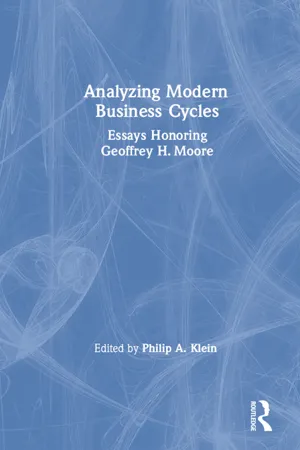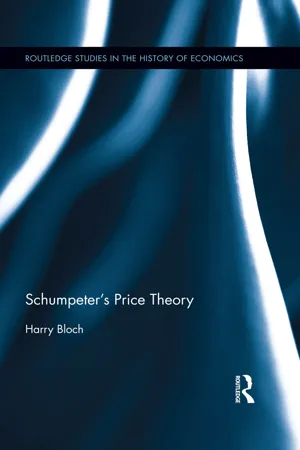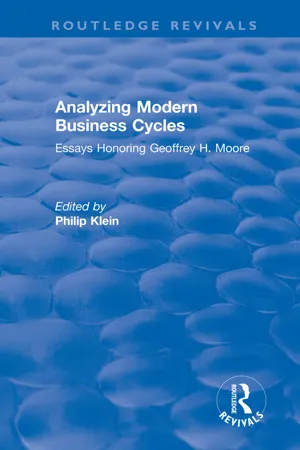Economics
Business Cycle Graph
A business cycle graph is a visual representation of the fluctuations in economic activity over time. It typically shows the alternating periods of expansion and contraction in an economy, including peaks, troughs, and the phases in between. By tracking changes in key economic indicators such as GDP, employment, and consumer spending, the graph helps to illustrate the cyclical nature of economic growth and recession.
Written by Perlego with AI-assistance
Related key terms
4 Key excerpts on "Business Cycle Graph"
- eBook - ePub
Economics for Investment Decision Makers
Micro, Macro, and International Economics
- Christopher D. Piros, Jerald E. Pinto(Authors)
- 2013(Publication Date)
- Wiley(Publisher)
Whereas the chapter on national income accounting and growth focused on long-term economic growth and the factors that help foster it, this chapter addresses short-term movements in economic activity. Some of the factors causing such short-term movements are the same as those causing economic growth, such as changes in population, technology, and capital. However, other factors, such as money and inflation, are more specific to short-term fluctuations.This chapter is organized as follows. Section 2 describes the business cycle and its phases, explaining the behaviors of businesses and households that typically characterize phases and transitions between phases. Section 3 provides an introduction to business cycle theory, in particular how different economic schools of thought interpret the business cycle and their recommendations with respect to it. Section 4 introduces basic concepts concerning unemployment and inflation, two important economic policy concerns that are sensitive to the business cycle. Section 5 discusses variables that fluctuate in predictable time relationships with the economy, focusing on variables whose movements have value in predicting the future course of the economy. A summary and practice problems conclude the chapter.2. OVERVIEW OF THE BUSINESS CYCLE
Burns and Mitchell (1946) define the business cycle as follows:Business cycles are a type of fluctuation found in the aggregate economic activity of nations that organize their work mainly in business enterprises: a cycle consists of expansions occurring at about the same time in many economic activities, followed by similarly general recessions, contractions, and revivals which merge into the expansion phase of the next cycle; this sequence of events is recurrent but not periodic; in duration, business cycles vary from more than one year to 10 or 12 years.This long definition is rich with important insights. First, business cycles are typical of economies that rely mainly on business enterprises—therefore, not agrarian societies or centrally planned economies. Second, a cycle has an expected sequence of phases representing alternation between expansion and contraction. Third, such phases occur at about the same time throughout the economy—that is, not just in agriculture or not just in tourism but in almost all sectors. Fourth, cycles are recurrent (i.e., they happen again and again over time) but not periodic (i.e., they do not all have the exact same intensity and duration). Finally, cycles typically last between one and 12 years. - eBook - ePub
Analysing Modern Business Cycles: Essays Honoring Geoffrey H.Moore
Essays Honoring Geoffrey H.Moore
- Philip A. Klein(Author)
- 2019(Publication Date)
- Routledge(Publisher)
Classical cycles historically have been the main concern of business cycle studies at the National Bureau of Economic Research (NBER) in New York. The NBER studies began with the work of Mitchell (1927; see Moore and Zarnowitz 1986). The classical cycle fits the business cycle theories of Kalecki (1939) and Schumpeter (1939). It also fits the hints Keynes (1936) offered about the nature of business cycles; and it is the cycle that is clearly at the heart of the post-Keynesian models of, for instance, Kaldor (1940) and Hicks (1950). Table 3.1 shows that there was no classical contraction in the United States between February 1961 and December 1969, a period of 106 months; Table 3.2 shows a classical upswing continuing in Australia from September 1961 to July 1974, a period of 154 months. The experience of the 1960s, especially in the United States with no classical downturn between 1961 to 1969, contributed to a revival of interest in growth cycles. 4 Growth cycles are defined as fluctuations in the rate of growth of aggregate economic activity, with periods when the growth rate is above the long-term trend rate alternating with periods when it is below this long-term value, but not necessarily negative. This enables account to be taken of the important fact that a slowdown may occur when the growth rate, though continuing positive, is slower than the long-term trend rate of growth. Hence excess capacity, notably unemployment, rises. On the other hand, during the expansion phase of the growth cycle, when excess capacity is being absorbed, the actual rate of growth is above the long-term trend rate of growth. Table 3.1 Phases of Business Cycles, U.S., 1948–87 Sources: a CIBCR 1988a. b U.S. Department of Commerce 1988, p - eBook - ePub
- Harry Bloch(Author)
- 2017(Publication Date)
- Routledge(Publisher)
Business cycle theory and statistical methodsMainstream economics generally treats business cycles as arising from external shocks to the economy. These shocks disturb equilibrium, but only temporarily, as markets adjust to the shocks through a self-equilibrating process. For Schum-peter, business cycles are not aberrations, but rather an inherent part of the process of economic evolution associated with the introduction and absorption of innovations. Innovations lead to booms as entrepreneurs compete for means of production, such that, ‘The recurring periods of prosperity of the cyclical movement are the form progress takes in capitalistic society ’ (Schumpeter, 1927, p. 30, italics in the original). Recessions, in turn, are part of the process of adjustment to structural change required by the innovations, as old ways of doing things are replaced by the new.Schumpeter’s theory of the business cycle is an essential component of his theory of economic development starting from the first edition of Theorie der wirtschaftlichen Entwicklung (Schumpeter, 1926 [1912]), the precursor to the edition used for the English translation in the Theory of Economic Development (TED ) (Schumpeter, 1961 [1934]). During the period from the mid-1920s to the mid-1930s, Schumpeter references this theory in a number of journal articles, both contrasting it to the contemporaneous theories of others (as in Schumpeter, 1927, 1930) and using it as the basis for explaining the unevenness of growth under capitalism (as in Schumpeter, 1928, 1935). In the process, he puts forward a number of arguments about the necessity of integrating theory, statistics and historical analysis to achieve a full understanding of business cycles.The culmination of Schumpeter’s research on business cycles is the two-volume Business Cycles (BC) , published in 1939. While the discussion of business cycles appears in the last chapter of TED , in BC the cyclical aspect of development takes centre stage. There is an extended discussion of each of the four cycle phases, prosperity, recession, depression and recovery, along with a discussion of a multiplicity of cycles of different lengths overlapping each other. BC also contains a discussion of the application of statistical method to the interpretation of cycles and trend in time-series data. Finally, the bulk of BC - eBook - ePub
Analyzing Modern Business Cycles: Essays Honoring
Essays Honoring
- Philip A Klein(Author)
- 2017(Publication Date)
- Routledge(Publisher)
Classical cycles historically have been the main concern of business cycle studies at the National Bureau of Economic Research (NBER) in New York. The NBER studies began with the work of Mitchell (1927; see Moore and Zarnowitz 1986). The classical cycle fits the business cycle theories of Kalecki (1939) and Schumpeter (1939). It also fits the hints Keynes (1936) offered about the nature of business cycles; and it is the cycle that is clearly at the heart of the post-Keynesian models of, for instance, Kaldor (1940) and Hicks (1950). Table 3.1 shows that there was no classical contraction in the United States between February 1961 and December 1969, a period of 106 months; Table 3.2 shows a classical upswing continuing in Australia from September 1961 to July 1974, a period of 154 months. The experience of the 1960s, especially in the United States with no classical downturn between 1961 to 1969, contributed to a revival of interest in growth cycles. 4 Growth cycles are defined as fluctuations in the rate of growth of aggregate economic activity, with periods when the growth rate is above the long Table 3.1 Phases of Business Cycles, U.S., 1948-87 Table 3.2 Phases of Business Cycles, Australia, 1950-87 term trend rate alternating with periods when it is below this long-term value, but not necessarily negative. This enables account to be taken of the important fact that a slowdown may occur when the growth rate, though continuing positive, is slower than the long-term trend rate of growth. Hence excess capacity, notably unemployment, rises
Learn about this page
Index pages curate the most relevant extracts from our library of academic textbooks. They’ve been created using an in-house natural language model (NLM), each adding context and meaning to key research topics.



